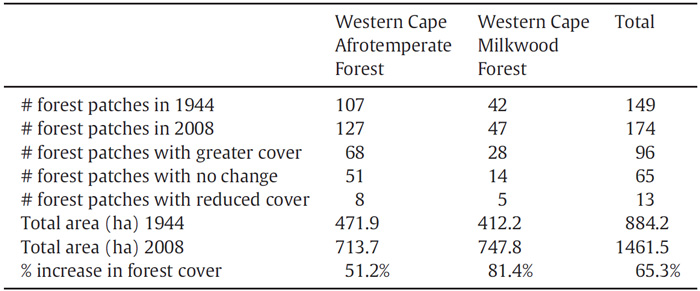| Tweet | Follow @co2science |
Paper Reviewed
Poulsen, Z.C. and Hoffman, M.T. 2015. Changes in the distribution of indigenous forest in Table Mountain National Park during the 20th Century. South African Journal of Botany 101: 49-56.
The world's forests provide a number of vital ecosystem services that benefit both society and nature alike. However, in recent years many have opined that the future of forests is in doubt. Deforestation, drought, fire, insect outbreaks and global warming represent only a handful of the many challenges that are claimed to be causing a near-term demise in forest health that is predicted to become only worse in the years and decades to come. But how valid are these fears? Are Earth's forests truly on the eve of destruction?
Though there are indeed some locations that are suffering from a variety of maladies, there are many that are not. In fact, multiple studies reveal forests that are thriving, with many increasing in productivity and expanding their ranges (see, for example, the many reviews we have posted on our website under the heading Greening of the Earth and Forests). And they are typically accomplishing these things despite all the real and imagined assaults on Earth's vegetation that have occurred over the past several decades, including wildfires, disease, pest outbreaks, deforestation, and climatic changes in temperature and precipitation, which more than compensate for any of the negative effects these phenomena may have inflicted upon them.
A recent example of this phenomenon is presented in the work of Poulsen and Hoffman (2015), who examined aerial and ground-based photographs to estimate long-term changes in the distribution of forests on the Cape Peninsula of South Africa. Specifically, the pair of researchers analyzed a series of forest-related characteristics from aerial photographs taken in 1944 and 2008, along with 50 historical ground-based repeat photographs that were initially imaged between 1888 and 1980 and then repeated in 2011 or 2012.
As shown in the table below, examination of the aerial photographs revealed there was an overall increase in forest cover of 65% between 1944 and 2008. And with respect to the ground-based repeat photographs, Poulsen and Hoffman report finding "an overall decrease in cover of more than 5% of visible rock and sand" (indicating more vegetative cover).

In discussing their findings, Poulsen and Hoffman state "the aerial and repeat ground-based photograph datasets have shown that there has been a significant increase in the number of patches of forest as well as in forest cover on the Cape Peninsula since 1888 when the earliest repeat photos were taken." In fact, as revealed in Table 1, overall forest cover has increased by more than 65 percent since 1944. And in areas where coverage has not increased, the two authors say they "are primarily situated along the coast where developments have expanded and replaced [the forest]."
As for the cause of the observed forest increase, Poulsen and Hoffman note that "increases in woody vegetation cover have increasingly been attributed to increases in elevated atmospheric CO2 levels," though they say it is difficult to establish that link here because "there has been no research on the effects of elevated CO2 on South African indigenous forest taxa." A more likely cause, in their view, is fire exclusion; yet that conclusion may be somewhat shaky, considering the fact that they report mean fire return intervals have declined from 31.6 to 13.5 years since 1975, which decline should not have favored forest growth.
Whatever the cause, or causes, one thing is clear. Cape Peninsula forests are far from approaching any tipping point leading to their destruction. In fact, we find that in many other locations throughout the world (see the many references cited in the links presented above), forests are defying alarmists projections of their demise, as they successfully cope with and adapt to the many challenges humanity and nature force upon them. Now that's good news worth sharing!
Posted ?? March 2016



